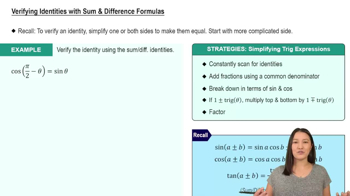Here are the essential concepts you must grasp in order to answer the question correctly.
Sum and Difference Formulas
The sum and difference formulas in trigonometry allow us to express the sine and cosine of the sum or difference of two angles in terms of the sines and cosines of those angles. For example, the cosine difference formula states that cos(A - B) = cos(A)cos(B) + sin(A)sin(B). These formulas are essential for simplifying expressions involving trigonometric functions.
Recommended video:
Verifying Identities with Sum and Difference Formulas
Exact Values of Trigonometric Functions
Exact values of trigonometric functions refer to the specific values of sine, cosine, and tangent for commonly used angles, such as 0°, 30°, 45°, 60°, and 90°. Knowing these values allows for quick calculations and simplifications in trigonometric problems. For instance, cos(30°) = √3/2 and sin(30°) = 1/2 are examples of exact values that can be used in various calculations.
Recommended video:
Introduction to Trigonometric Functions
Product-to-Sum Formulas
Product-to-sum formulas convert products of sine and cosine functions into sums or differences, which can simplify calculations. For example, the formula cos(A)cos(B) = 1/2[cos(A + B) + cos(A - B)] is useful for transforming expressions like cos(75°) - cos(15°) into a more manageable form. This transformation is particularly helpful when finding exact values or further simplifying trigonometric expressions.
Recommended video:
Verifying Identities with Sum and Difference Formulas





